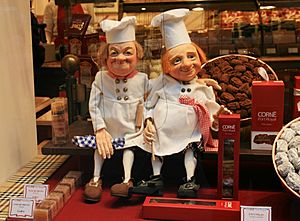Praline (Belgian chocolate) facts for kids

Belgian chocolate fondants
|
|
| Type | Confectionery |
|---|---|
| Place of origin | Belgium |
| Main ingredients | Chocolate |

Pralines are delicious chocolates with a soft filling inside. They are also known as Belgian chocolates or chocolate bonbons. These tasty treats usually have a chocolate shell that melts easily.
Pralines were first created in 1912 by Jean Neuhaus II. He was a Belgian chocolatier, which is someone who makes and sells chocolates.
Contents
What Are Pralines?
Pralines are special chocolates that always have a hard chocolate shell. Inside, they have a soft, yummy filling. There are many different types and shapes of pralines.
Two Meanings of "Praline"
The word "praline" can sometimes be a bit confusing! In Belgium, "praline" usually means any filled chocolate. This is what we are talking about in this article.
But "praline" can also mean a specific kind of filling. This traditional filling is made from caramelised nuts. These nuts, like hazelnuts or almonds, are ground into a smooth paste. Sometimes, milk products are added to make it even creamier.
Popular Praline Fillings
Belgian chocolates are not just limited to the traditional nut paste filling. They come with many exciting flavors inside!
Some popular fillings include nuts, marzipan (a sweet almond paste), salted caramel, and coffee. You might also find them filled with fruit flavors like cherry. Sometimes, they have a special chocolate blend that tastes different from the outer shell.
Pralines are often sold in fancy boxes. These boxes make them perfect as a gift for someone special.
Famous Praline Makers
Several companies are very famous for making Belgian pralines. The biggest ones include Neuhaus, Godiva, Leonidas, and Guylian. These companies make millions of delicious pralines every year!

